- Publisher |
- Al Ridenour
- Media Type |
- audio
- People |
- Country Of Origin |
- USA
- Produced In |
- Los Angeles, CA
- Premiere Date |
- 2018-04-24
- Frequency |
- Periodic
- Explicit |
- No
This podcast currently has no reviews.
Submit ReviewOur understanding of hypnotism, once known as “mesmerism,” has radically evolved over the centuries. This episode looks at where it all began, examining the fascinating (and rather weird) story of the 18th-century German doctor, Franz Anton Mesmer, after whom “mesmerism” is named.
We begin, with a look at the mesmerist’s sinister reputation in the 19th century, as reflected in the British writer George du Maurier’s 1894 novel, Trilby. While the book’s named for its protagonist, Trilby O’Ferrall, an Irish girl working as a model in a British artist’s colony in Paris, her nemesis is better known, namely, her vocal instructor, Svengali, an Eastern European musician whose hypnotic powers not only propel the aspiring singer to stardom but also come to dominate and ruin her life. We look at the novel’s forgotten popularity in its day, the phenomenon of “Trilbyana,” and the book’s cinematic adaptations, including the 1931 film, Svengali, with John Barrymore in the title role. Along the way, we note some surprising parallels with more prominently gothic novels and films.
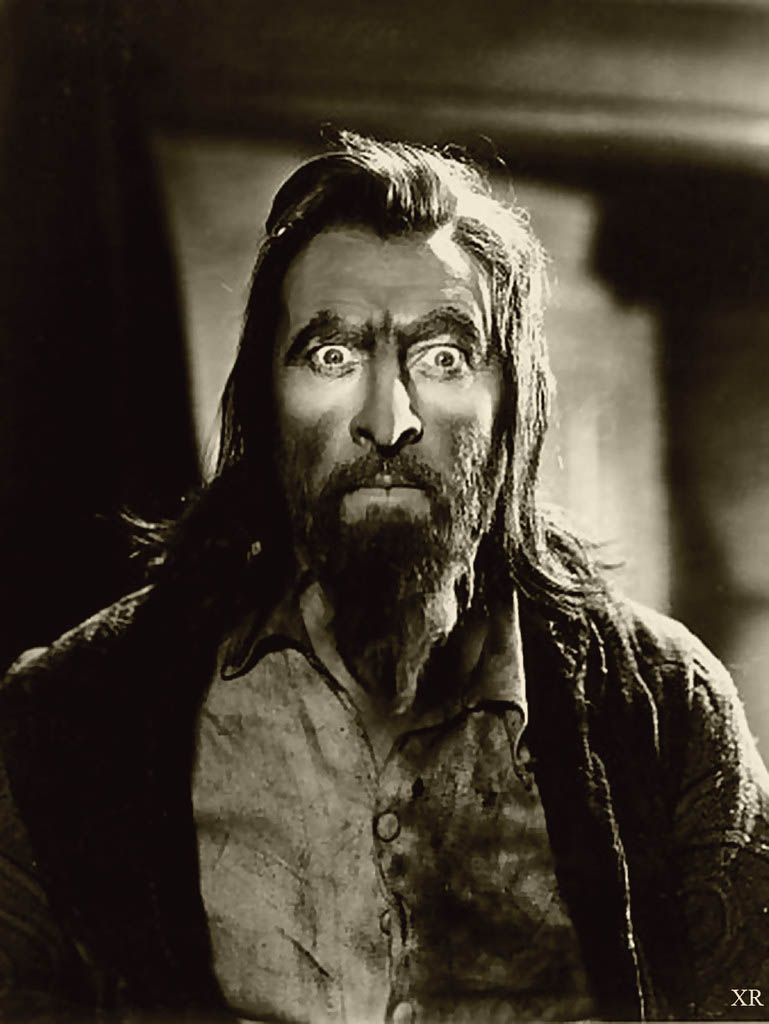 John Barrymore as Svengali in the 1931 film of that name.
John Barrymore as Svengali in the 1931 film of that name.
Beginning with Mesmer’s dubious scholarship at the University of Vienna, we make an attempt to untangle his concept of “animal magnetism,” describing an invisible, dynamic fluid, comparable to the “cosmic magnetism” that guides the planets, but particular to “animals” (i.e., creatures sharing an “animus” (L) or animating spirit.
We particularly focus on Mesmer’s experiences while in Hungary, where in 1775 he was summoned by a Baron Horeczky de Horka, who hoped the German doctor’s new form of therapy might succeeds where treatments of his condition by others had failed. We hear of several curious incidents occurring in the castle, which were documented in detail the family tutor and interpreter Herr Seifert, who had observed Mesmer with a skeptical fascination, expecting the man to be a charlatan.
 Franz Anton Mesmer
Franz Anton Mesmer
We next look at Mesmer’s return to Vienna where he attempted the cure of Marie Paradies, a talented musician blind since the age of three who mingled with the musical elites of her city and was regarded with favor by the Imperial court.
As the results here were dubious at best, we then follow Mesmer on his escape to Paris, where he becomes a faddish celebrity. Mrs. Karswell reads for us a lengthy descriptions of his “magnetic salons,” as observed by a Scottish physician, John Grieve, during a visit to Paris in 1784. During that same year, however, Mesmer’s increasing fame drew the attention of the state, and his techniques were the subject of two Commissions called by Louis XVI. The results were unfortunate for Mesmer but provide listeners with some tasty descriptions of the collective madness involved in those salons.
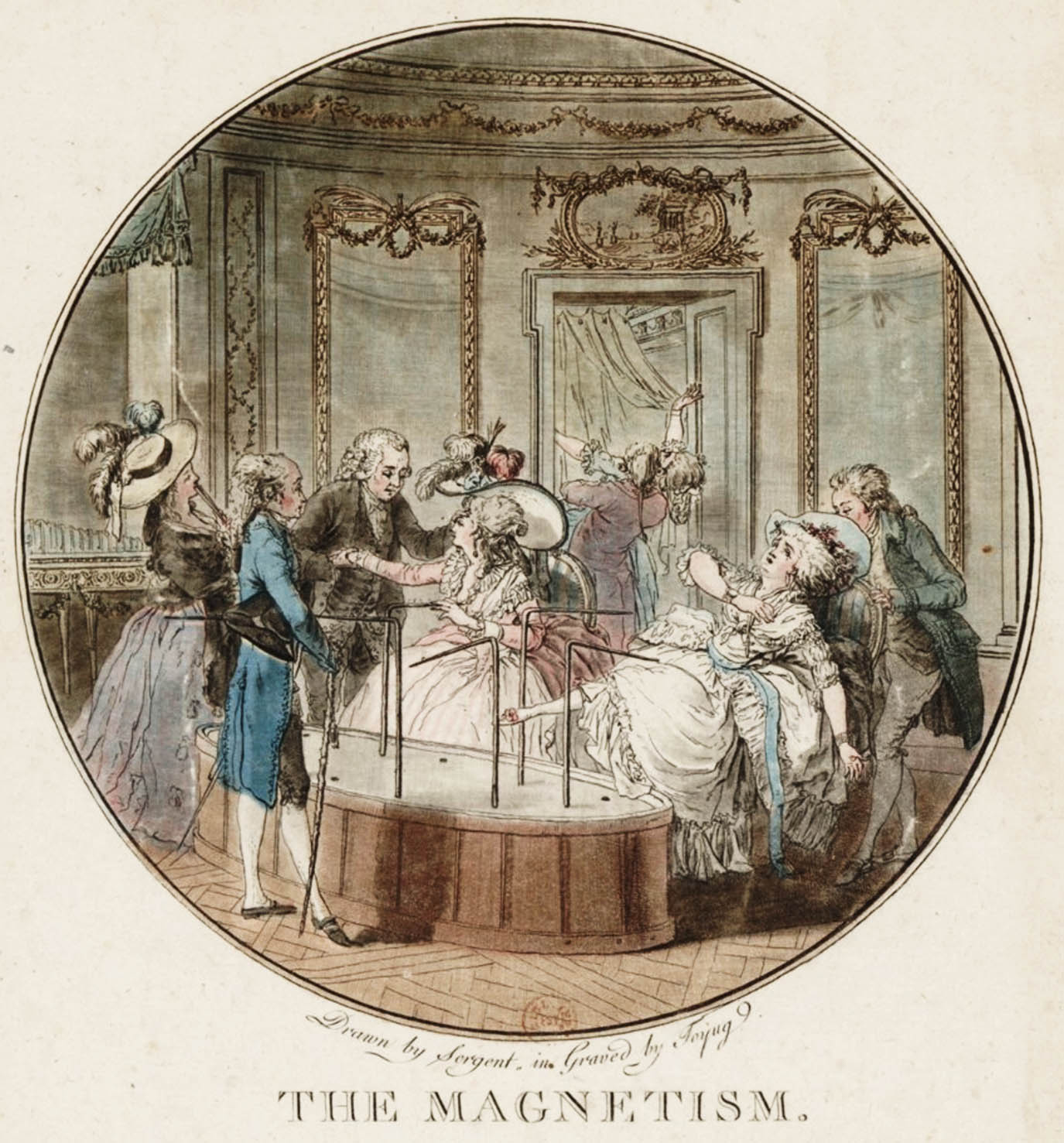 Period illustration showing Mesmer’s patients around the magnetic baquet.
Period illustration showing Mesmer’s patients around the magnetic baquet.
We then have a look at the connection between Mesmer and the Mozarts (primarily father Leopold but to some extent also his musical Wunderkind, Wolfgang,) and here we note Mozart and Mesmer’s mutual fondness for the glass harmonica — Ben Franklin’s invention consisting of a series of glass bowls of descending size mounted on a horizontal spindle, rotated by a foot treadle and played with a wetted finger. While Mesmer considered its sound to have healing “magnetic” properties, others regarded the unearthly sounds with suspicion, and so we hear a bit of lore about the glass harmonica’s “cursed” (and even lethal) reputation during the 18th century.
The show closes with a charming story about a canary kept by the great mesmerist until the day of his death, which is also described.
NOTE: This episode also references the new publication, We Need to Talk About Death, a book by our very own Sarah Chavez, which is now HzqRuThn0PDkwEwtXGNfAYh7Uf4m8W7cGSoy1-UbM1QVKMQbzeVBKaqwatB-4vcYQmTC1bYDkKVJq2Ol7ERaQxmkEZfRnurUNboAgeGPCA123qOq2sqGkhVkZmQIJMtNjh3Fkne8iVFNks9106YZVjB97PjH9FTAt3wDxoNNVMqBqbMTmH78Cx-TadNnRZ3BM7zhG-ouM-gG6kjPnblMMB3M7u-w.FlBBbPB0xSy139FidVZtjqn-akfNbdP498JW-mYxLbQ&dib_tag=se&keywords=sarah+chavez&qid=1713632408&sprefix=sarah+chave%2Caps%2C193&sr=8-1">available from Amazon and through stores near you.
The post The Mesmerist appeared first on Bone and Sickle.
Banshees are spirits of Irish folklore, who warn of impending deaths. Originally considered fairies, their Irish name, bean sídhe, means “woman of the mounds,” those mounds (sídhe) being the ancient burial mounds believed in Ireland to be the home of fairies.
The banshee’s wailing, which betokens imminent death of a blood relative, is probably based upon the wailing of Irish mourners called “keeners,” from the Irish word caoineadh, or “lament.” You can hear some snippets of traditional keeners in this segment, incliuding a 1957 field recording released by Smithsonian Folkways.
Next we look at how the banshee’s appearance and behavior derives in part from that of Irish keeners, including some odd details having to do with petticoats. Her origins in the fairy world also has often suggested that she may be small of stature. We also examine some folktales involving combs lost by or stolen from banshees, and what you should or should not do should you find one.
of-ireland.png" alt="" width="640" height="839">
While the banshee is attached strictly to particular families, she is not bound to the Emerald Isle. We hear some accounts of her following travelers to other countries, including a surprising tale involving a party aboard an Italian yacht.
The figure, as she’s known today, receives no mention in print until the 17th century. Mrs. Karswell reads for us what is probably the earliest account, retelling an incident experienced by Lady and Sir Richard Fanshawe, an English ambassador and his wife visiting Ireland.
This account also introduces the notion that a banshee may not originate in the fairy world, but may also be a vengeful ghost. We hear another tale in this mode associated with Dunluce Castle in County Antrim, a location known for its “banshee room,” a feature duplicated in Shane’s Castle, about an hour to the south. Both of these castle banshees are sometimes called “the red sisters,” so named for the color of their hair.
After a brief side trip to make note of figures similar to the banshee in Scotland (the caoineag) and Wales, the cyhyraeth and gwrach y rhibyn, we turn to older figures of the fairy realm regarded as banshees, but rather different from the figure born in the Early Modern Period.
The first of these is Clíodna, who was known as the queen of the banshees of southern Ireland, particularly the province of Munster. Unlike the modern banshee, a solitary figure who does little more than wail and make those well-timed appearances, Clíodna engages in romantic affairs, including a romantic rivalry with her banshee sister Aoibhell, a matter culminating in a magical battle with both transformed into cats.
Aoibhell also appears in an important story about Brian Boru, founder of the O’Brian Dynasty, whose army defeats an alliance of Vikings and Irish lords fought at the Battle of Clontarf, near Dublin in 1014. While Boru’s forces are victorious, he and his son are visited by Aoibhell, who heralds their deaths not with a wail, but music played on her harp from the fairy world. We hear a similar story about the Irish hero and demi-god Cúchulainn encoutering Aoibhell as a death omen.
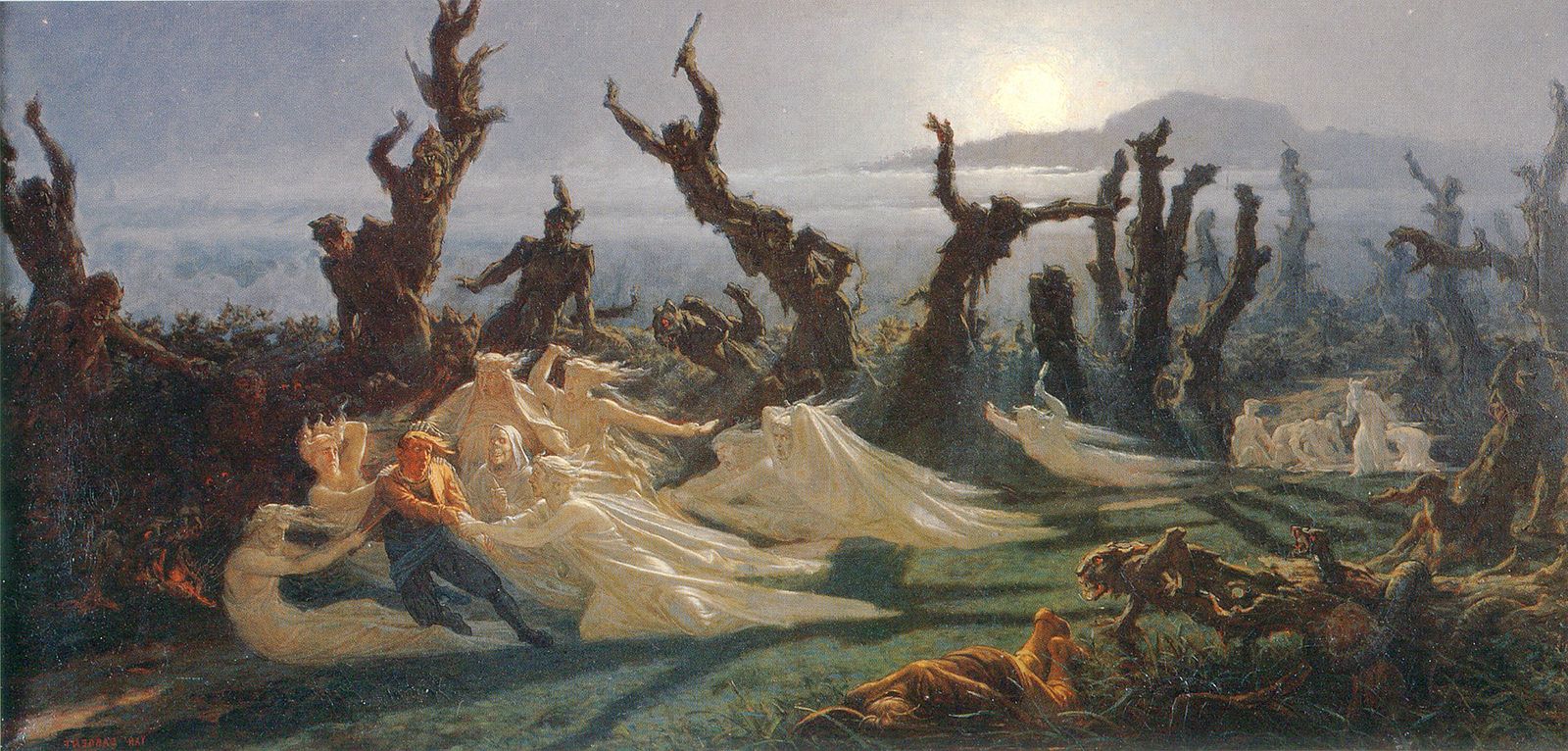 Les Lavandières de la nuit, 1861, Yan’ Dargent, oil,
Les Lavandières de la nuit, 1861, Yan’ Dargent, oil,
Cúchulainn also encounters a banshee-like figure of the type folklorists call, “the Washer at the Ford,” or in Celtic regions elsewhere, like Celtic Britanny, “the Midnight Washer.” The figures appear at lonely bodies of water washing bloody shrouds, or often armor, as they are particularly inclined to predict the deaths of soldiers and armies. We hear a particularly splendid account of one such figure from the 12th-century Triumphs of Torlough — one, which in its generous use of horrific adjectives sounds as if it were written by H.P. Lovecraft.
The episode ends with a quick look at a couple cinematic bamshees, including one which has earned a place in the nightmares of children encountering it in the 1950s-70s. The two movies we hear bits of are Damned by Dawn and Darby O’Gill and the Little People.
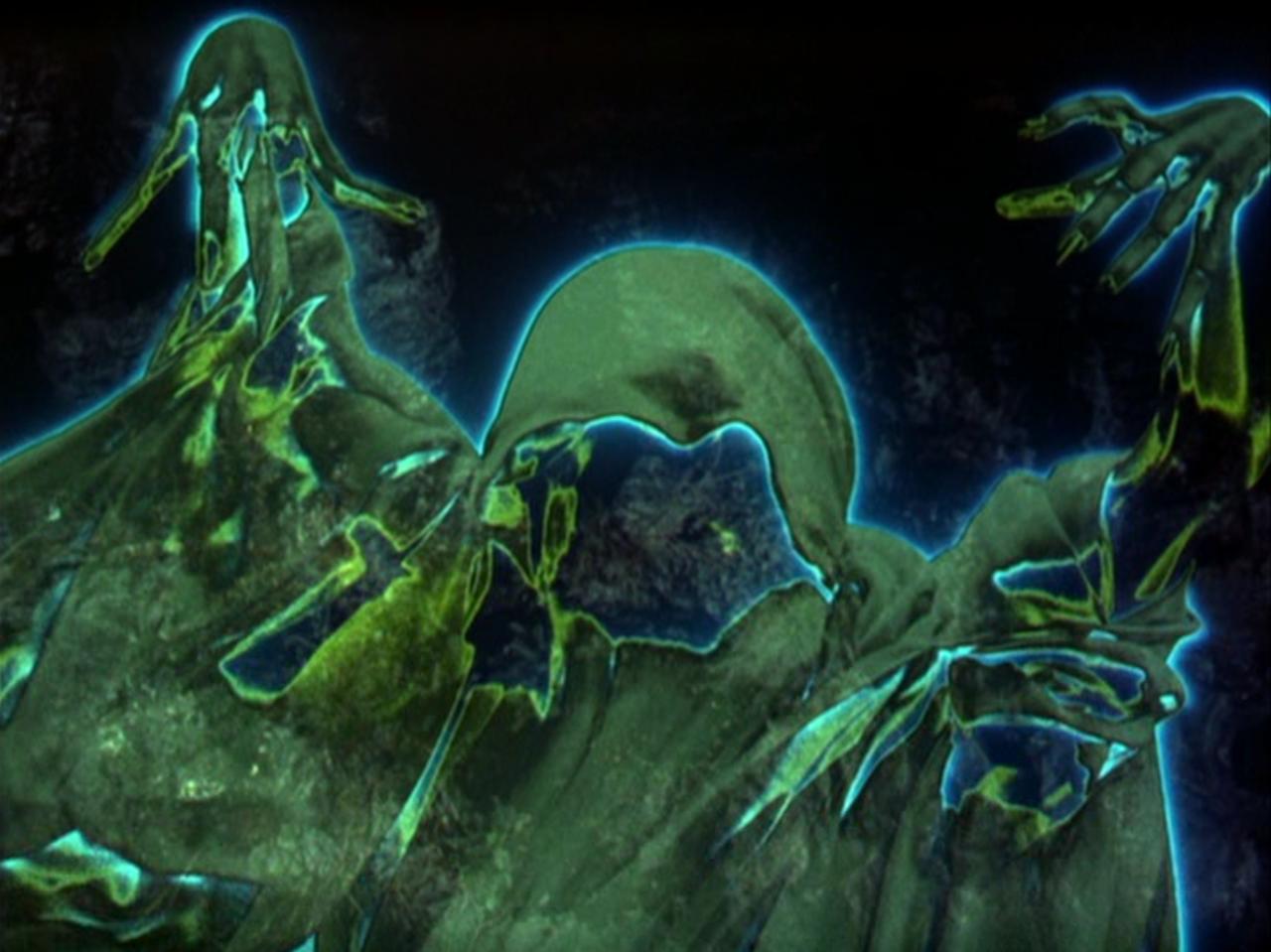 Banshee from “Darby O’Gill”
Banshee from “Darby O’Gill”
The post Banshees (Rebroadcast) appeared first on Bone and Sickle.
The story of Snow White, as told by the Brothers Grimm, is only one of many narratives involving girls who have fallen into a deathlike state and are displayed in a glass coffins. In this episode, we examine the sordid details of the Grimm’s original 1812 version of the tale and compare it with analogous stories dating back to the 12th century.
We begin with a review of the Grimms’ original story, many aspects of which have been subsequently muddled and obscured not only by Disney but by later alterations made by the Grimms. These include the identify of the Evil Queen, the malevolence of her intent, the purported benevolence of the Huntsman, and particularly, the nature of Snow White’s resurrection.
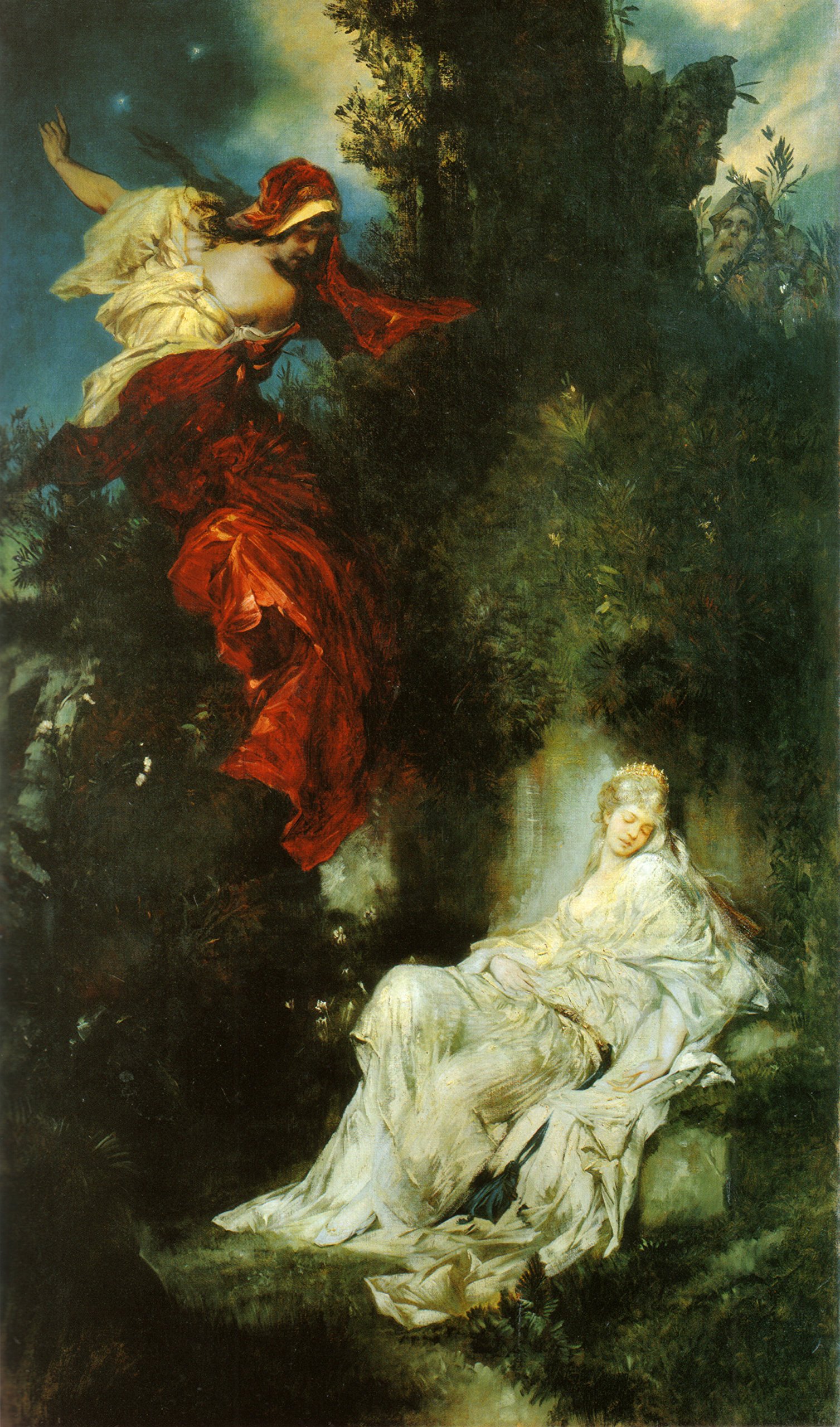 “Snow White Receives the Poisoned Comb” Hans Makart (1872)
“Snow White Receives the Poisoned Comb” Hans Makart (1872)
After this, we have a look at the immediate predecessor to the 1812 story, a children’s play of the same name by the (unrelated) German author Albert Ludwig Grimm. Though it features dwarves who aid Snow White, a magic mirror addressed in rhyme, poisoned fruit, deception involving the heroine’s purported death, and glass coffin, it proves to be a very different story.
The next tale explored is the 1782 novella Richilde, by the German writer Johann Karl August Musäus. Surprisingly, the title character here, Richilde, is the wicked stepmother rather than her step-daughter Bianca, whose name in Italian (i.e., “white”) might be compared to “Snow White.” Set in medieval Brabant (Belgium), this one has Bianca courted by a prince whom the jealous stepmother hopes to see married to her own daughter. A further complication is presented by the fact that the prince here is already married.
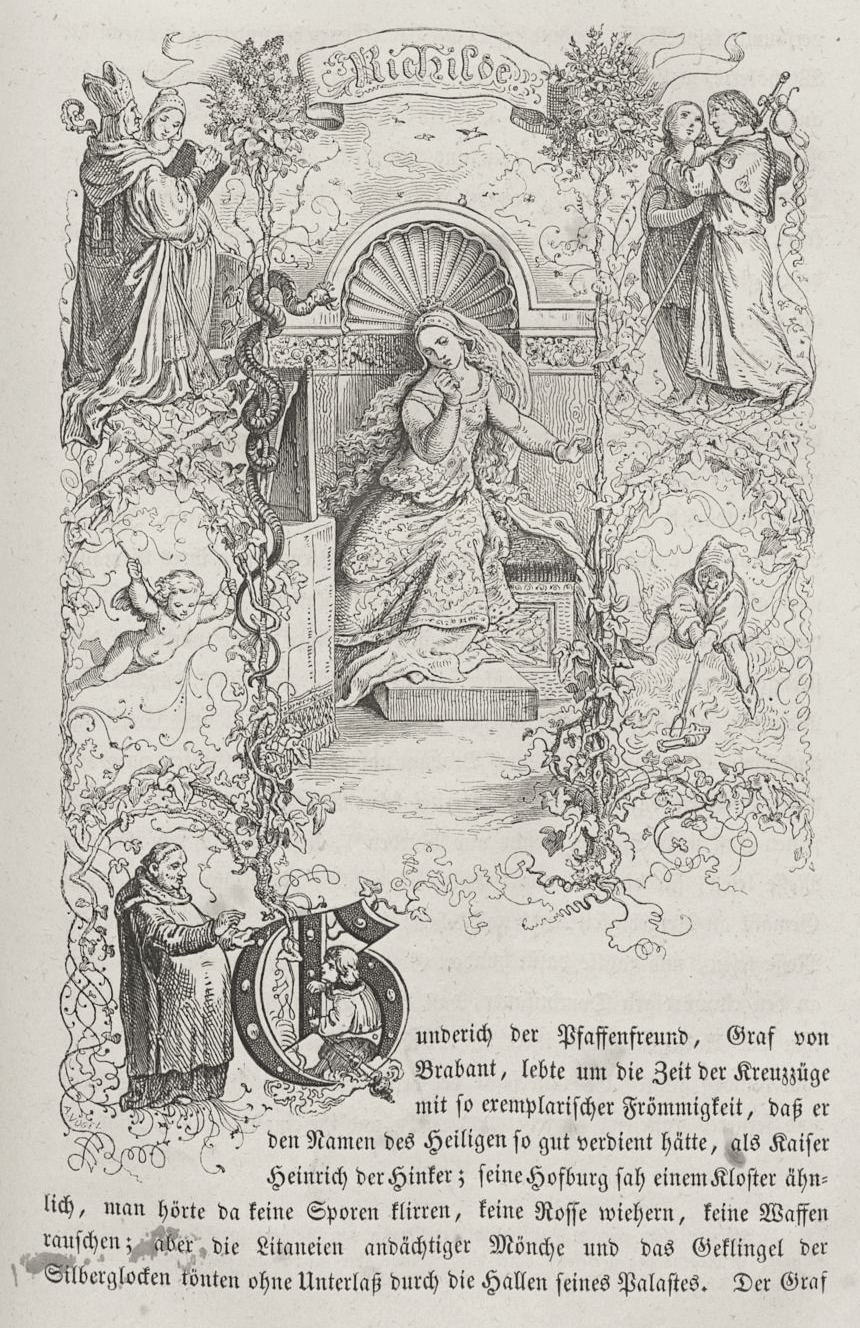 Richilde Title Page
Richilde Title Page
We then take a look at the rarely mentioned Russian story, “The Tale of the Old Mendicants,” (my translation) published in the 1794 collection, An Old Song in a New Setting, or a Complete Collection of Ancient Folk Tales, Published for a lover of them, at the expense of the Moscow merchant Ivan Ivanov (my translation). In this one, the role of the Evil Queen is played by an innkeeper jealous that her guests have complimented the beauty of her daughter rather than her own. The alms-collecting monks of the title are used by the mother to deliver a poisoned shirt to the Snow White character, Olga the Beautiful.
Our next offering comes from the 1634 volume by Neapolitan writer Giambattista Basile, Il Pentamerone, or The Tale of Tales, the very first collection of fairy tales, with which the Brother Grimm were definitely familiar (and one featured in our earlier “Dark Fairy Tales” episodes, both One and Two ). The story in question is “The Little Slave,” which combines elements of Snow White, Sleeping Beauty, and Cinderella. Here, the Snow White character, Lisa, again falls into a death-like swoon and is kept within not one but seven glass coffins in a locked room. The story resolves itself with the aid of a doll, a whetstone, and a knife.
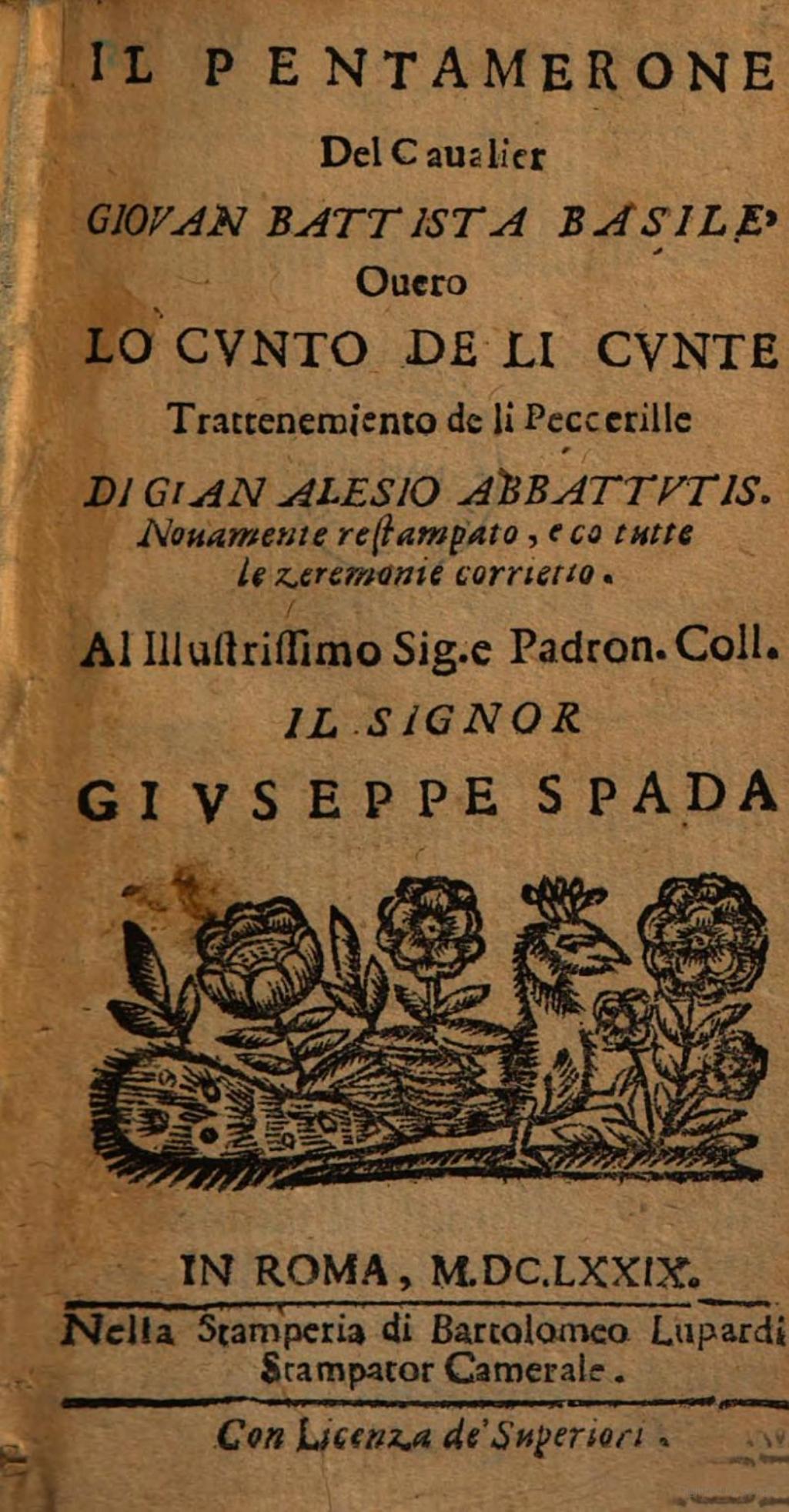 Il Pentamarone
Il Pentamarone
Our earliest story paralleling Snow White, is quite a bit older — from the 12th-century, the Lai of Eliduc by Breton writer Marie de France. While serving a king in England, the Breton knight Eliduc falls in love with his lord’s daughter, Guillardun, who falls into a swoon during an ocean voyage. Eliduc (who is not exactly innocent when it comes to Guillardun’s condition) transports the body of his love back to France and keeps it on the altar of a deserted woodland chapel. In this case, the story resolves itself thanks to a very clever weasel.
After our more detailed examination of these strangely paralleled stories, we take a quick look at the wide range of more recent variants that were committed to print after the Grimms published their work and at a rather ugly controversy that engulfed German town, Lohr am Main, after it claimed to be the birthplace of the Snow White Legend.
Our episode ends with Mrs. Karswell’s reading a particularly dark and brutal tale about seven dwarves collected by Swiss historian and folklorist Ernst Ludwig Rochholz in his 1856 volume, Swiss Legends of the Aargau.
 Lohr am Main Snow White state.
Lohr am Main Snow White state.
The post Glass-Coffin Girls appeared first on Bone and Sickle.
A few listeners commented that Mrs. Karswell’s dialogue was muffled at points in “Sorcery Schools of Spain.” That episode is now updated with a corrected version. Thanks for letting us know.
The post Audio Fix on Episode 125 appeared first on Bone and Sickle.
For centuries, Spain was said to be the home of secret, underground sorcery schools, Toledo being the first city with this reputation and later Salamanca. The notoriety of the latter was more enduring, and when the legend passed to Spanish colonies of the New World, the word, “Salamanca” was embraced as a generic term for any subterranean location said to be the meeting place of witches. We begin the show with a clip from the 1975 Argentine film Nazareno Cruz and the Wolf, which depicts just such a place.
A particularly early reference to this concept can be found in a romanticized 12th-century biography of a particularly interesting character, a French pirate and mercenary Eustace the Monk. Mrs. Karswell reads for us a passage written by an anonymous poet of Picardy, who describes Eustace’s occult schooling in the city of Toledo. Along with this we hear as a passage from a 1335 Tales of Count Lucanor by Juan Manuel, Prince of Villena, which adds another element to the legend, that of its underground location.
Curiously, a number of Spanish cities claim as their founder the Greek demigod Hercules, but in Toledo, he’s also credited with founding this school of magic, excavating a subterranean space in which he imparts his supernatural knowledge, at first in person, and later in the form of a magically animated sculpted likeness. Another Toledan legend, was later blended into this mythology. It’s the story in the Visigoth King Roderick, Spain’s last Christian ruler makes a discovery prophesying his defeat by the Moors in 711 CE. Along with a parchment foretelling this, Roderick exploration of this enchanted palace or tower results in the discovery of the Table of Solomon, a construction of gold, silver, and jewels also attributed with occult powers. Legends detailing this are believed to be of Arabic origin, first recorded in the 9th century and later appearing in One Thousand and One Nights. In later Spanish retellings, the treasure house is conflated with the Cave of Hercules, and the fall of Spain to the Moors is attributed to Roderick breaking of a spell woven by Hercules, to keep North African invaders at bay.
 Roderick breaking into the tower of Hercules, 14th c manuscript.
Roderick breaking into the tower of Hercules, 14th c manuscript.
By the 16th century, this site (now identified as an ancient Roman structure underlying Toledo’s church of San Ginés) had inspired such wild tales that Cardinal Juan Martinez Siliceo organizes a 1547 expedition into a subterranean space in hopes of putting the rumors to rest, but it hardly succeeded at that. Mrs. Karswell reads a dramatic 1625 account of that misadventure.
While talking bronze heads and magic mirrors were being added to descriptions of the Toledo site, in the late medieval period, similar legends began to be told in Salamanca. Being the site of one of Europe’s most ancient universities in a time when scholars were not infrequently misunderstood as magicians, legends of this sort would naturally be associated with Salamanca. But unlike the universities of Paris, Padua, and Bologna, Salamanca’s location in Spain made it a center of Moorish learning and the study of Arabic texts filled with strange calligraphy, figures and charts readily passing for books of magic.
As Salamanca’s reputation emerged later, in an era after the witch trials had begun, instruction no longer was provided by a figure from classical mythology but from the Devil, one of his demons, or a professor or student in league with the Dark One. A favorite character filling this role was the Marqués de Villena, a scholar who’d written books on alchemy and the evil eye. Villena appears in a number of literary works of the era, both in Europe and the New World. In the 1625 play, The Cave of Salamanca, by Mexican dramatist Juan Ruiz de Alarcón, Villena figures into a scenario that became fairly standard in Salamanca stories, one involving the Devil’s payment for the lessons provided. This would be demanded in the form of a human soul, the victim chosen by lot among the seven students instructed at the end of a seven-years period.
In Salamanca, the underground location of this magic school is strangely associated with a Christian site, the Church of San Cyprian, a significant choice, as St. Cyprian of Antioch has strong occult associations throughout the Catholic world but especially in Spanish and Portuguese-speaking regions. Before Cyprian came to Christianity, this 3rd-century saint is supposed to have been a sorcerer and is sometimes referred to as “Cyprian the Magician”. His story is mirrored in Portugal by that of Giles of Santarém, and both figures appear in Spanish and Portuguese literary works in which the saints play roles parallel to that of the Marqués de Villena, and the magic school becomes “The Cave of Cyprian.”
There are also legends that the magical secrets of the pre-conversion Cyprian were preserved, and on the Iberian Peninsula particularly (but also prominently in Scandinavia) grimoires and spell books attributed to Cyprian began circulating as early as the 16th century. After a brief look at the history of these magic books, we turn our attention to the New World and their legacy there. In particular, the use of such books in Portuguese folk magic brought Cyprian the Magician to Brazil where, where he was absorbed into the syncretic religions of that country. The practice of Macumba, one of these religions synthesizing West and Central African beliefs with those of Catholicism, and 19th-century Spiritism, Cyprian the Magician is transmogrified into São Cipriano dos Pretos Velhos, or Saint Cyprian of the “Old Blacks” an embodiment of the departed African Ancestors. Our show ends with a Macumba chant dedicated to this figure and a Spanish prayer to St. Cyprian for protection against witches, curses, and the evil eye.
The post Sorcery Schools of Spain appeared first on Bone and Sickle.
Tonight we bring you our sixth annual Christmas ghost story, a tradition particularly beloved in Victorian and Edwardian Britain. First published in 1908, and set in the days before Christmas, the tale is by British writer Algernon Blackwood (from whom we earlier heard “Ancient Lights“) and whom many listeners will know through his other works, particularly, The Wendigo or The Willows. Throw a log on the fire, refill the brandy, and settle back for Mrs. Karswell’s reading of “The Kit Bag.”
The post A Christmas Ghost Story VI appeared first on Bone and Sickle.
The Christmas season is rich in superstitions. The whole period from the beginning of Advent, through the day itself, and especially throughout the twelve days (and nights!) between Christmas and January 6 or Epiphany are, in a sense haunted, a time when spirits are afoot and behavior is hemmed in by restrictions upon normal activities. Recently I stumbled upon a good collection of these folk beliefs in a volume from 1903 entitled Encyclopaedia of Superstitions, Folklore, and the Occult Sciences of the World: (And subtitled, A Comprehensive Library of Human Belief and Practice in the Mysteries of Life). The book’s contents are indeed as comprehensive as that title, and from their section on Christmas, I’ll be sharing some of the more interesting examples.
The show closes with a recording of a song sung by costumed Swiss holiday figures known as Silvesterchläuse. In the hinterlands of the Canton of Appenzell-Ausserrhoden, the se Silvesterchläus, groups of men and male youths wearing huge bells and ornate costumes, go door to door to offer seasonal blessings and sing songs like the one you will hear.
The post Christmas Superstitions appeared first on Bone and Sickle.
The Monster of Glamis was a Victorian legend involving a Scottish castle, a secret chamber, and a monstrous aristocrat hidden from the world–a perfect story for Bone and Sickle’s return to its old format, a 45-minute deep-dive into the castle’s lore, including its association with Macbeth, a legend of a cursed Earl’s card game with the Devil, as well as theories regarding the extravagant measures employed to keep the castle’s terrible secret. Along the way, we learn a bit about other secret chambers in castles and estates of Britain, a scandal involving the Royal Family, and a connection between the Glamis legend and a popular literary trope of the day, one embraced in Gothic fiction and later in the pulps and horror films. We even hear Lon Chaney, Jr. sing!
 Glamis Castle
Glamis Castle
The post The Monster of Glamis appeared first on Bone and Sickle.
Tonight we recreate for you elements of an old-fashioned Halloween party as experienced in the 1920s or ’30s. Foods, games, spooky stories and poems in an extra-long Halloween episode.
For more retro delights of the era, listen to Episode 35 “Vintage Halloween.”

The post An Old-Fashioned Halloween Party appeared first on Bone and Sickle.
“The Spook House,” an 1899 short story by Ambrose Bierce is suitably spooky for the season, but not in the way you expect.It was a favorite of H. P. Lovecraft, who praised its “terrible hints of a shocking mystery.” Also, a macabre bit of poetic whimsy from A.E. Houseman, and an intruder is welcomed in Mr. Ridenour’s library.
The post The Spook House appeared first on Bone and Sickle.
This podcast could use a review! Have anything to say about it? Share your thoughts using the button below.
Submit Review





